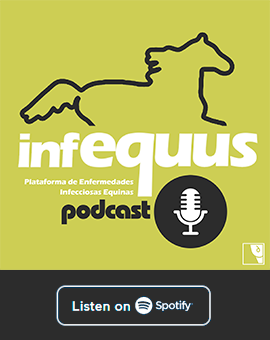Coccidiodomycosis
Etiology
Coccidioidomycosis (Syn: Valley fever, California fever, Desert rheumatism, San Joaquin Valley fever) is a fungal disease caused by Coccidioides spp., a dimorphic pathogenic fungus. Two genetically distinct species have been recently identified, namely Coccidioides immitis and Coccidioides posadasii; the first species was identified in California, and the second in Central and South America. A few cases of coccidioidomycosis in horses have been reported, and most of them represent disseminated forms of C. immitis infection.
Epidemiology
Present exclusively in the Western Hemisphere between latitudes 40 ° N and 40 ° S. It is characteristic of soils arid and semi-arid zones. C. immitis is found exclusively in the San Joaquin Valley in southern California; while C. posadasii in the rest of the known endemic areas in Arizona and Texas in the United States; in the states of Sonora, Nuevo León, Coahuila and Baja California in Mexico and in regions of Central and South America. In general, the fungus is found on the ground at 20-25 cm from the surface. A short rainy season is required to stimulate the growth of the mycelial form. The return to the conditions of drought and wind are necessary for the widespread dissemination of the arthrospores produced. The disease is not contagious between individuals or through vectors and its presentation is usually sporadic. Occasionally, epidemic outbreaks may occur in endemic areas associated with factors that favor the dissemination of arthrospores. This spread can be related to natural factors (dust storms, earth tremors, ground faults) or anthropogenic (constructions, archaeological excavations, military practices).
Pathogeny
The infection occurs after the inhalation of the arthrospores. Once inside the lung tissue, the arthrospore hydrates and increases in size until it forms a pilocyte of about 60 μm, followed by endosporulation by centripetal segmentation. The mature giant spherule contains between 200-300 endospores that begin to grow isotropically and that are released when the mother spherule explodes. The endospores can form new spherules and colonize other tissues by contiguity, via lymphohematogenous, or transported by phagocytes, but very often the initial infection activates the macrophages and the release of the endospores triggers an intense and effective inflammatory response, which aborts the infection in this point, leaving a permanent immunity.
If the cellular immunity is not effective, the evolution is granulomatous, usually proliferative. In some cases the infection may remain latent, while in others the disease progresses, spreading through the lungs and other tissues, especially bone, skin and subcutaneous and even meningeal. There may be transplacental transmission in pregnant females. The infection is always sensitizing; Progressive forms may be more or less acute, but they tend to be deadly.
Clinical signs
Infections are characterized by respiratory, dermatological, musculoskeletal, neurological and ophthalmological clinical signs. Animal may show fever, coughing, lameness, musculoeskeletal pain, abortion, colic or skin lesions.
Diagnosis
Fungal cultures or biopsies which are positive for C. immitis, together with serological evidence, are useful to diagnose the infection. Microscopic examination of tissues or of transtracheal or bronchoalveolar lavage fluids, lymph nodes and pleural fluid exudates, can be performed using KOH (or KOH-ink), lactophenol cotton blue, H&E, Papanicolau, PAS, methenamine silver stains. Coccidioides spp. grows within 2–5 days on several media. Fungal culture should be restricted to biosafety level 3 laboratories. Serological tests (i.e., Agar Gel Immunodiffusion (AGID) assays and ELISA for the detection of IgM and IgG antibodies) may assist the diagnosis of coccidioidomycosis. An IgG titre lower than 1:8 may be indicative of an exposure to the organism, albeit without the development of disease.
Treatment
Treatments in horses might be required in cases of >10% weight loss, presence of lung infiltrates and IgG titres > 1:16. Treatment is successful when the plasma level of antifungal agents is at least equal to the minimum inhibitory concentration values for C. immitis. Imidazoles (itraconazole, fluconazole) and amphotericin B may be used but the treatments, in general, have to be prolonged (6 months).
Prevention and control
Prevent horses from visiting endemic areas as much as possible and remaining in closed and isolated enclosures during sandstorms or activities that involve earth movement. There is no vaccine available.
Public Health Considerations
Humans are susceptible to coccidiodomicosis, and although anyone is exposed to inhalation infection in endemic areas, given the frequency with which it is found in the powder, it has a certain professional character. Also exposed are doctors, veterinarians and laboratory workers who handle fungi. It is recommended to work in level 3 biosafety conditions or at least the use of primary barriers such as masks, gloves and goggles when handling contaminated samples. No cases of direct transmission between horses and people have been described.
References
- Cafarchia C, Figueredo LA, Otranto D. Fungal diseases of horses. Vet Microbiol. 2013 Nov 29;167(1-2):215-34. doi: 10.1016/j.vetmic.2013.01.015. Epub 2013 Jan 29. Review. PubMed PMID: 23428378.
- Higgins JC, Leith GS, Pappagianis D, Pusterla N. Treatment of Coccidioides immitis pneumonia in two horses with fluconazole. Vet Rec. 2006 Sep 9;159(11):349-51. PubMed PMID: 16963715.
- Shubitz LF, Dial SM. Coccidioidomycosis: a diagnostic challenge. Clin Tech Small Anim Pract. 2005 Nov;20(4):220-6. Review. PubMed PMID: 16317911.
- Higgins JC, Pusterla N, Pappagianis D. Comparison of Coccidioides immitis serological antibody titres between forms of clinical coccidioidomycosis in horses. Vet J. 2007 Jan;173(1):118-23. Epub 2005 Oct 24. PubMed PMID: 16249106.
- Higgins JC, Leith GS, Voss ED, Pappagianis D. Seroprevalence of antibodies against Coccidioides immitis in healthy horses. J Am Vet Med Assoc. 2005 Jun 1;226(11):1888-92. PubMed PMID: 15934257.
- Kramme PM, Ziemer EL. Disseminated coccidioidomycosis in a horse with osteomyelitis. J Am Vet Med Assoc. 1990 Jan 1;196(1):106-9. PubMed PMID: 2295541.


